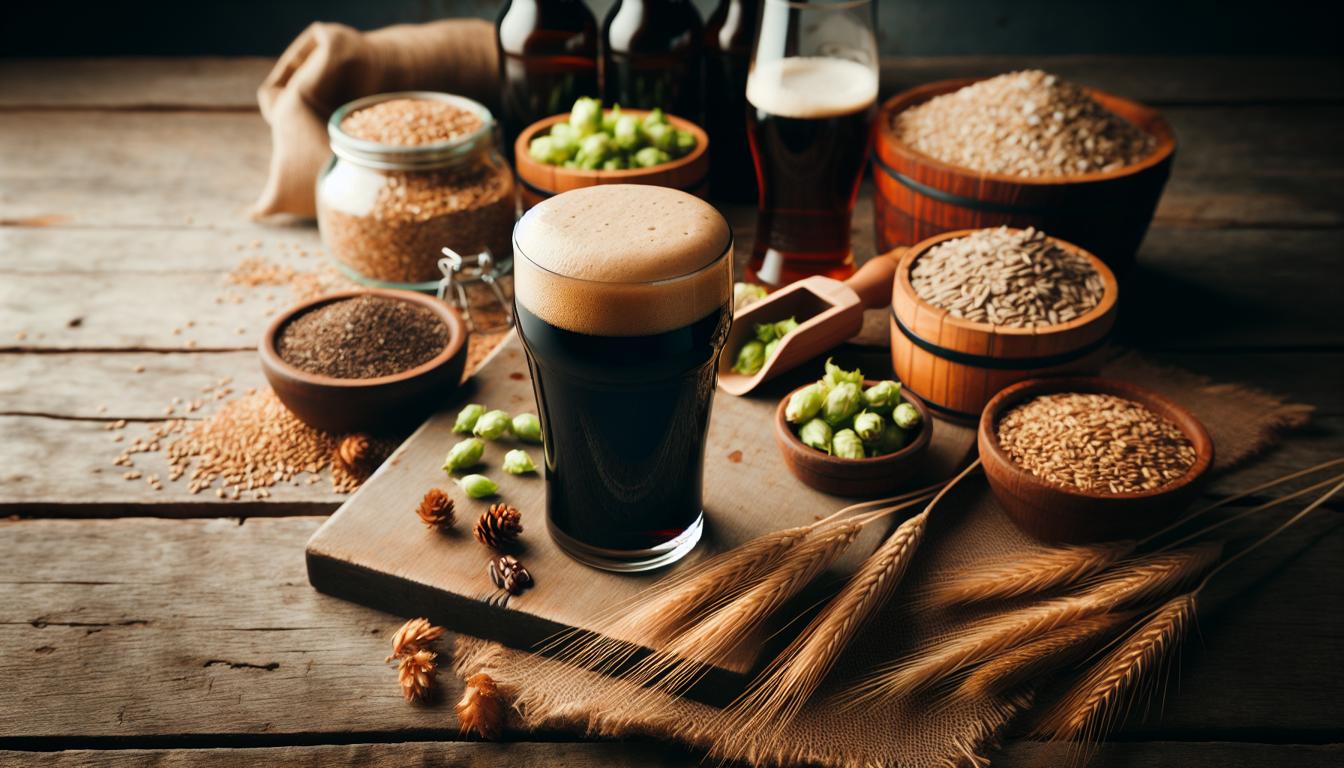Welcome, fellow brewers, to this comprehensive guide on how to brew a classic Dry Stout. This beer style has a rich history and a unique set of characteristics that make it a favorite among beer enthusiasts worldwide. In this post, I will take you through the step-by-step process of brewing a Dry Stout, sharing personal anecdotes and expert advice along the way.
A Brief History and Key Characteristics
The Dry Stout, also known as an Irish Stout, has its origins in Ireland, where it was first brewed in the late 18th century. It gained popularity in the 19th century and eventually became synonymous with the iconic Guinness brand.

This beer style is characterized by its deep black color, creamy tan head, and a dry, roasted flavor profile. It is a low-alcohol beer, typically ranging from 4 to 5% ABV, with a moderate bitterness and a smooth mouthfeel. The aroma is often described as having notes of roasted barley, coffee, and dark chocolate.
Recipe
Now, let’s get to the heart of the matter – the recipe for brewing a delicious Dry Stout. Below, you will find a detailed breakdown of the ingredients and brewing process. Remember, brewing is both an art and a science, so feel free to experiment and make adjustments to suit your taste preferences.
Ingredients
– 7.5 lbs (3.4 kg) of Pale Ale Malt – This will serve as the base malt for our Dry Stout.
– 1 lb (0.45 kg) of Roasted Barley – This specialty malt will contribute to the dark color and roasted flavors of the beer.
– 0.5 lb (0.23 kg) of Flaked Barley – This will add body and improve head retention.
– 0.25 lb (0.11 kg) of Chocolate Malt – This malt will provide additional depth and complexity to the beer’s flavor.
– 1 oz (28 g) of East Kent Goldings hops – This traditional English hop variety will contribute to the beer’s bitterness and aroma.
– 1 packet of Dry Stout yeast – Choose a yeast strain that is well-suited for stouts, such as Irish Ale yeast or a Dry Stout-specific strain.
– 5 gallons (19 liters) of water – Ensure that your water is suitable for brewing, free from any chlorine or chloramine.
Instructions
1. Mashing – Begin by heating your strike water to around 152°F (67°C). Add the grains to your mash tun and slowly pour in the hot water, stirring gently to ensure even distribution. Let the mash rest for 60 minutes, maintaining a temperature of 150-154°F (66-68°C). This will extract the sugars from the malt, providing food for the yeast during fermentation.
2. Lautering – After the mash has rested, it’s time to separate the liquid wort from the spent grains. Slowly drain the wort into your brew kettle, taking care to avoid any grain particles. This process, known as lautering, can be done by using a sparge arm or by batch sparging.
3. Boiling – Once you have collected all the wort in your brew kettle, bring it to a boil. As soon as it reaches a rolling boil, add the East Kent Goldings hops. Boil the wort for 60 minutes, ensuring a gentle but consistent bubbling. This will allow the hops to release their bitterness and aroma into the beer.
4. Chilling and Fermentation – After the boil, it’s time to cool the wort as quickly as possible to a temperature suitable for yeast pitching. Use an immersion chiller or a counterflow chiller to bring the temperature down to around 68°F (20°C). Once the wort is at the desired temperature, transfer it to your sanitized fermentation vessel and pitch the yeast.
5. Fermentation – Fermentation is a critical step in the brewing process. Maintain a consistent temperature of around 68°F (20°C) throughout the fermentation period, usually lasting about 7-10 days. This will allow the yeast to convert the sugars into alcohol, while also producing the desired flavors and aromas.
6. Bottling or Kegging – After fermentation is complete, it’s time to package your Dry Stout. If you prefer bottle conditioning, add the appropriate amount of priming sugar to carbonate the beer. Alternatively, if kegging, transfer the beer to a sanitized keg and force carbonate using CO2. Allow the beer to carbonate for a couple of weeks before serving.
Expert Tips and Advice
As an experienced brewer, I’ve learned a few tricks along the way that can help you brew a truly exceptional Dry Stout. Here are some expert tips and advice to keep in mind:
– Water Chemistry – Pay attention to your water chemistry, as it can greatly impact the final flavor of your beer. Adjustments can be made using brewing salts to achieve the desired balance of minerals.
– Roasted Barley – Be cautious when using roasted barley, as it can easily overpower the beer with a harsh, acrid flavor. Start with a smaller amount and adjust the quantity in future batches based on your taste preferences.
– Yeast Selection – Choose a yeast strain that complements the flavors and aromas of a Dry Stout. Irish Ale yeast or a Dry Stout-specific strain will give you the best results.
– Fermentation Temperature – Maintain a consistent fermentation temperature to ensure that the yeast performs optimally. Fluctuations in temperature can lead to off-flavors and other fermentation issues.
– Patience – Brewing a Dry Stout requires patience. Give the beer ample time to condition and develop its flavors. It’s worth the wait!
Conclusion
Brewing a Dry Stout is a labor of love. It requires careful attention to detail and a deep understanding of the ingredients and brewing process. By following the recipe and tips outlined in this guide, you will be well on your way to crafting a delicious Dry Stout that will impress even the most discerning beer connoisseurs.
Remember, brewing is a journey of discovery, so don’t be afraid to experiment and make the recipe your own. Cheers to your brewing success, and may your Dry Stout bring you joy and satisfaction with every sip!
Frequently Asked Questions about Brewing Dry Stouts
What are the key ingredients for brewing Dry Stouts?
A: The main ingredients for brewing Dry Stouts include malted barley, roasted barley, water, hops, and yeast. The distinctive roasted barley contributes to the beer’s dark color and coffee-like flavors.
How does the mashing process differ for Dry Stouts?
A: The mashing process for Dry Stouts involves using a variety of malts, including roasted barley. This imparts the desired roasted and chocolate flavors while keeping the sweetness to a minimum.
Can I use any yeast strain for brewing Dry Stouts?
A: While various yeast strains can be used, traditional Irish ale yeast is commonly chosen for Dry Stouts. It ferments at moderate temperatures, contributing to the beer’s clean and dry profile.
What’s the ideal fermentation temperature for Dry Stouts?
A: Aim for a fermentation temperature between 60-68°F (15-20°C) to achieve the desired balance of flavors. This range allows the yeast to produce the characteristic dryness without introducing off-flavors.
Do Dry Stouts require any special conditioning?
A: Yes, Dry Stouts benefit from a maturation period to allow the flavors to meld. Cold conditioning, or lagering, at temperatures around 38-45°F (3-7°C) for a few weeks helps refine the beer.
Can I experiment with additional ingredients in Dry Stout recipes?
A: While the classic recipe remains popular, feel free to experiment with adjuncts like coffee, chocolate, or oats. Just be mindful of the balance to maintain the Dry Stout’s signature dryness.





Leave a Reply
You must be logged in to post a comment.